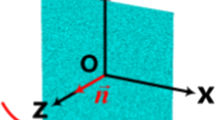This article discusses the issues of introducing broadband technologies to civil and special-purpose radar systems. The popularity of these technologies in terms of solving numerous practical problems determines the relevance of research related to a detailed analysis of long-range portraits of objects observed at a new qualitative level. Using the results of broadband radar sounding, this study analyzes the influence of the systematic error of the measuring channel on the reliability of the identification of the geometric shape of the local reflectors of observation objects. A broadband radar-measuring channel with a linear frequency modulation of the signal is created on the basis of the generalized heterodyning method. Then, a technique for compensating systematic measurement errors for a given type of channel is proposed using calibration spheres. The systematic error in measuring the frequency characteristics (FCs) of the sphere is estimated, and an error indicator for estimating the FCs of objects is proposed. Furthermore, the dependence of the statistical indicators of the identification results of the geometric shape of local reflectors on the specified indicator is presented. The possibility of identifying the geometric shape of local reflectors through the parameters of their FCs is confirmed experimentally. The results obtained can be used to assess the reliability of the identification of the geometric shape of local reflectors at the calibration stage of the measuring channel and to make a decision on the feasibility of implementing algorithms for the identification of the geometric shape of local reflectors on an existing radiolocation station.





Similar content being viewed by others
References
J. Eaves and E. Reedy, Principles of Modern Radar, Springer US (2012).
M. Skolnik, Radar Handbook, McGraw-Hill (2008).
M. Jankiraman, FMCW Radar Design, Artech House (2018).
R. Cetiner, Q. Cetintepe, S. Demir, and A. Hizal, “Prospects of FMCW-based frequency diverse array radar,” J. Eng., 11, No. 21, 7299–7303 (2019), https://doi.org/10.1049/joe.2019.0458.
M. Kang, B. Kim, H. Kim, and S. Park, “A Study on pulsed-LFM and pulsed-NLFM waveforms for radar systems,” 2019 Int. Conf. on Information and Communication Technology Convergence, Jeju Island, Korea (South) (2019), pp. 983–985, https://doi.org/10.1109/ICTC46691.2019.8940010.
M. Klotz and H. Rohling, “24 GHz radar sensors for automotive applications,” Int. Conf. on Microwaves and Radar, MIKON2000, Wroylaw, Poland (2000), pp. 359–362, https://doi.org/10.1109/MIK0N.2000.913944.
H. Rohling, M. Meinecke, and R. Mende, “A 77 GHz automotive radar system for AICC applications,” Int. Conf. on Microwaves and Radar, Krakow, Poland (1998), pp. 273–277, https://doi.org/10.1109/RADAR.2000.851845.
L. Junya and L. Yue, “Data augmentation based on attributed scattering centers to train robust CNN for SAR ATR,” Access IEEE, 7, 25459–25473 (2019), https://doi.org/10.1109/ACCESS.2019.2900522.
Y. Zou and X. Gao, “A high precision GTD parameter estimating method,” 8th Int. Congr. on Image and Signal Processing, Shenyang, China, Oct. 14–16, 2015, pp. 1220–1224, https://doi.org/10.1109/CISP2015.7408067.
H. Yan and L. Sheng, “Monostatic GTD model for double scattering due to specular reflections or edge diffractions,” IEEE Int. Conf. on Computational Electromagnetics, Chengdu, China, March 26–28, 2018, pp. 1–3, https://doi.org/10.1109/COMPEM.2018.8496539.
D. Dai and J. Zhang, “Superresolution polarimetric ISAR imaging based on 2D CP-GTD model,” J. Sens., 1, No. 11, 4–16 (2015), https://doi.org/10.1155/2015/293141.
J. Wang and E. Shaoming, “A GTD model and state space approach based method for extracting the UWB scattering center of moving target,” Sci. China, 54, No. 1, 182–196 (2011), https://doi.org/10.1007/s11432-010-4137.
Y. Cong and B. Chen, “Nonparametric Bayesian attributed scattering center extraction for synthetic aperture radar targets,” IEEE T. Signal Proces, 64, No. 18, 4723–4736 (2016), https://doi.org/10.1109/TSP.2016.2569463.
D. Barrio and C. Matran, “On approximate validation of models: a Kolmogorov–Smirnov-based approach,” TEST, No. 1, 23–28 (2019), https://doi.org/10.1007/s11749-019-00691-1.
E. Knott, J. Shaeffer, and M. Tuley, Radar Cross Section Measurements, SciTech Publishing (2006).
E. Knott, J. Shaeffer, and M. Tuley, Radar Cross Section, SciTech Publishing (2004).
Author information
Authors and Affiliations
Corresponding author
Additional information
Translated from Izmeritel’naya Tekhnika, No. 7, pp. 55–61, July, 2020.
Rights and permissions
About this article
Cite this article
Neelov, V.V., Shaldaev, S.E. Influence of the Estimation Accuracy of the Frequency Characteristics of Radar Targets on the Results of the Geometric Shape Identification of Local Reflectors. Meas Tech 63, 573–579 (2020). https://doi.org/10.1007/s11018-020-01825-w
Received:
Accepted:
Published:
Issue Date:
DOI: https://doi.org/10.1007/s11018-020-01825-w




